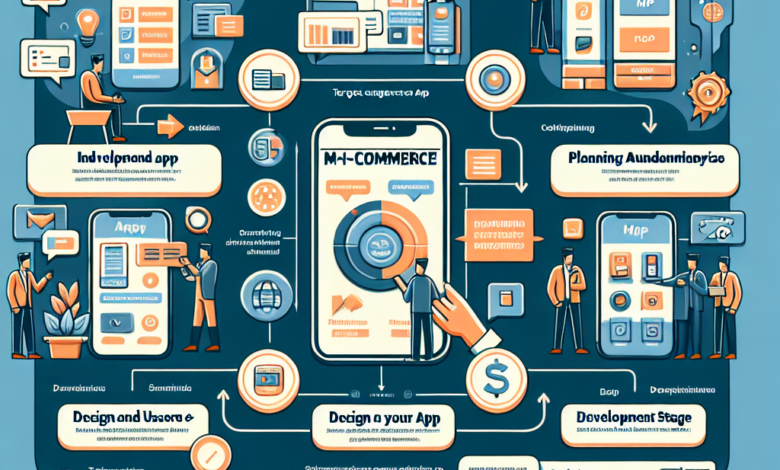Crafting the Future of Shopping Developpez votre application m-commerce

In today’s fast-paced digital world, mobile commerce (m-commerce) is not just a trend—it’s a necessity. Businesses across the globe are shifting their focus to mobile platforms to reach their tech-savvy consumers. With smartphones becoming an indispensable part of our lives, developing a tailored m-commerce app can provide your business with a significant edge. This blog post will guide you through the process of building an m-commerce app, offering insights and practical tips for entrepreneurs, mobile app developers, and e-commerce businesses.
Understanding M-Commerce
M-commerce refers to the buying and selling of goods and services through wireless handheld devices such as smartphones and tablets. It is an extension of e-commerce, allowing consumers to conduct transactions on-the-go. The scope of m-commerce is broadening as more users prefer the convenience of shopping via mobile apps.
Unlike traditional e-commerce, m-commerce offers speedier transactions, personalized experiences, and location-based services. These advantages make it a compelling choice for businesses looking to expand their reach and increase sales. With the global shift towards mobile-first strategies, understanding the nuances of m-commerce is crucial for success.
The benefits of m-commerce extend beyond convenience. It allows businesses to engage with their customers more intimately, offering tailored promotions and push notifications directly to their devices. This direct line of communication enhances customer loyalty and increases repeat purchases, making m-commerce a vital tool for modern businesses.
Target Audience Analysis
Identifying and understanding your target audience is a critical first step in developing a successful m-commerce app. Knowing who your customers are, their preferences, and how they interact with mobile technology will help shape your app’s features and functionalities.
Successful m-commerce apps like Amazon and ASOS have perfected the art of targeting their user base. Amazon leverages its vast data repository to deliver personalized shopping experiences, while ASOS focuses on young fashion-conscious individuals through its user-friendly interface and targeted marketing strategies. Studying these examples can provide valuable insights into how to effectively reach your audience.
To identify your target audience, start by analyzing consumer data and market trends. Conduct surveys and focus groups to gather firsthand insights. Use analytics tools to track user behavior, preferences, and purchasing patterns. This information will inform your app’s design and marketing strategies, ensuring you meet the needs of your audience.
Planning Your App
Before jumping into app development, it’s essential to set clear objectives. What do you want your m-commerce app to achieve? Whether it’s increasing sales, improving customer engagement, or expanding your market reach, having defined goals will guide your development process.
The features and functionalities of your app will depend on your business type. For retail businesses, incorporating a smooth checkout process and inventory management is crucial. Service-based businesses might focus on booking systems and customer support features. Prioritize features that align with your business objectives and enhance the user experience.
Consider integrating payment gateways, GPS services, and personalized recommendations to enhance functionality. Plan your app’s architecture and design wireframes to visualize the user flow. This planning phase is critical for identifying potential challenges and ensuring your app meets both business needs and user expectations.
Design and User Experience (UX)
In the competitive world of m-commerce, intuitive design and seamless user experience can set your app apart. A well-designed app ensures users can easily navigate through products, complete purchases, and access information without hassle.
Best practices for m-commerce app design include simplifying navigation, using familiar icons, and ensuring responsive design across all devices. Visual elements should be consistent with your brand, creating a cohesive and engaging experience for users.
User-centered design is key. Conduct usability testing with real users to gather feedback and make necessary adjustments. Pay attention to loading times, as slow apps can deter users. An intuitive, visually appealing app will not only attract users but also encourage them to return.
Development Phase
Choosing the right technology stack is vital for the success of your m-commerce app. Consider factors like scalability, security, and performance when selecting technologies. Popular stacks include MEAN (MongoDB, Express.js, Angular, Node.js) and MERN (MongoDB, Express.js, React, Node.js), which offer robust solutions for developing powerful applications.
Agile development methodologies are particularly relevant to m-commerce app development. With agile, you can adapt to changes quickly, incorporate user feedback, and deliver a product that meets market demands. It involves iterative cycles, allowing for continuous improvement and faster time-to-market.
Collaborate with experienced developers who understand both the technical and business aspects of m-commerce. Ensure your team follows best practices for coding and testing to build a reliable and secure app. Regular communication and updates will keep your project on track and aligned with your goals.
Testing and Quality Assurance
Thorough testing is essential to ensure a high-quality m-commerce app. It helps identify bugs, improve functionality, and enhance user experience. Testing should cover all aspects of your app, including usability, security, and performance.
Focus on key areas like payment processing, data protection, and user interface during testing. Conduct both manual and automated tests to cover different scenarios and use cases. User acceptance testing (UAT) is also crucial, as it ensures the app meets the needs and expectations of your target audience.
Quality assurance doesn’t end with the launch. Regular updates and maintenance are necessary to fix issues, improve features, and adapt to changing user needs. An ongoing commitment to quality will keep your app relevant and competitive in the m-commerce market.
Launch and Post-Launch Strategy
A successful app launch requires strategic planning and execution. Create a buzz around your launch through social media, email marketing, and collaborations with influencers. Offer promotions or exclusive deals to attract users and encourage downloads.
Post-launch, focus on user engagement and retention. Use push notifications, personalized content, and rewards programs to keep users active and loyal. Collect feedback and reviews to understand user satisfaction and areas for improvement.
Monitor app performance and make data-driven decisions to enhance features and fix issues. Engage with your community through regular updates and communication, ensuring a strong connection between your brand and its users.
Measuring Success
Tracking the success of your m-commerce app is essential for growth and improvement. Key performance indicators (KPIs) like user acquisition, retention rates, conversion rates, and average order value provide valuable insights into your app’s performance.
Tools like Google Analytics and Mixpanel offer comprehensive data analysis, helping you understand user behavior and app usage. Use these insights to refine your marketing strategies, improve features, and enhance the overall user experience.
Regularly review your KPIs and set benchmarks for success. Adjust your strategies based on performance data, ensuring your app continues to meet the needs of your audience and contributes to your business goals.
Future Trends in M-Commerce
The m-commerce landscape is constantly evolving, driven by emerging technologies and consumer expectations. Staying ahead of these trends is crucial for maintaining a competitive edge.
Technologies like augmented reality (AR) and virtual reality (VR) are transforming the shopping experience, allowing users to visualize products in their environment before making a purchase. Voice commerce is gaining traction, with voice assistants enabling hands-free shopping.
Sustainability and ethical practices are also influencing consumer choices. Incorporating eco-friendly features and transparent supply chains can attract socially conscious consumers. Adapting to these trends will ensure your m-commerce app remains relevant and appealing.
Conclusion
M-commerce apps are no longer optional—they’re essential for businesses looking to thrive in the digital age. By understanding your audience, planning carefully, and leveraging the right technologies, you can create an app that drives growth and engagement.
The future of m-commerce is bright, with endless opportunities for innovation and expansion. Now is the time to invest in your own m-commerce app development and transform your business for success.



